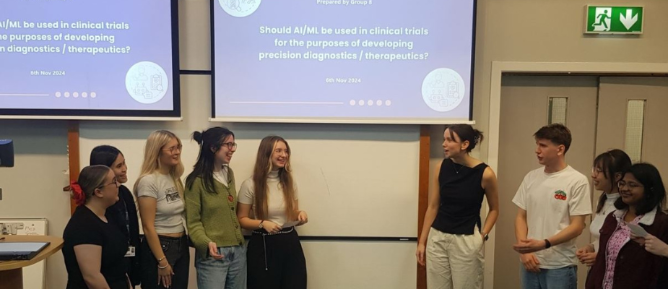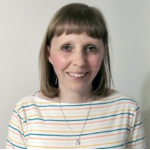
Group Debate in Precision Medicine
|
Title of case study |
Debate for Group Assessment in PGT Precision Medicine |
|
School/Subject: |
MVLS/Precision Medicine |
|
Lecturer(s): |
Carolyn Loveridge, Lesley Graham, Susan Lindsay |
|
Course: |
Precision Diagnostics and Therapeutics (BIOL5357) |
|
Student Level: |
PGT |
|
Class size:
|
50 |
|
Location: |
On campus/in person |
Brief summary
MSc Precision Medicine (with specialisms) programme leaders, Carolyn Loveridge, Lesley Graham, and Susan Lindsay designed and implemented an authentic debate groupwork assessment in the first taught course of the programme. Students, in small groups, were assigned sides of the topic (for/against), which they researched and debated in person, then students wrote individual reflections. Both the debate and reflective writing components were assessed.
Objectives
There were several objectives expected from applying this method. Firstly, the use of debate as a form of assessment was to offer an alternative method of assessment to e.g. a traditional essay, to help students build greater enthusiasm for the topic by fostering an engaging and active learning experience. It was hoped this would translate to better performance on the assessment. This was particularly relevant for the diverse cohort of international students whose satisfaction was directly linked to them doing better in the assignment.
Another objective with such diverse groups of students was for them to learn how to navigate dynamics of their different personalities to reach the project’s objectives and to enhance their critical thinking skills.
Lastly, the debate strived to be authentic by simulating similar debates which could be held in medical research/workplaces, thus helping to provide students with relevant employability skills which they will be expected to have for their future careers.
What is done?
Before the physical assessment takes place, the course leaders lead a scaffolded support structure to ensure the students understand the task and that their groups worked efficiently. This includes: (1) at the course introduction, students are assigned their groups and given time to have an initial discussion; (2) each group is required to submit a compulsory formative Moodle post early in the task regarding their division of tasks and their key topics of focus (N.B. course leaders provide feedback on these posts); (3) a one-hour tutorial dedicated to the debate assessment where students have the opportunity to participate in a mock debate on a slightly different topic to the assessment for practice; (4) a dedicated Q&A session to answer students’ final questions about the debate; (5) a session is delivered by SLD on reflective writing; and, (6) a dedicated one-hour tutorial on the reflective writing assessment.
For the course introduction and preparatory tutorials, active learning spaces that have Echo360 capability or using a microphone for manual recording are beneficial so that sessions can be recorded for students to review in their own time. While an active learning space would be ideal for the debate assessment itself, it can take place in any standard teaching room that has a PC and projector. Students can simply stand at the front of the room when delivering their opening presentation and then in their teams at the front of the room facing across from each other during the debate.
With regards to accessibility issues, buildings and rooms should be accessible for students with physical disabilities. Chairs could be provided should students have difficulty standing for the period of the debate. To date, no disability/neurodivergent student has raised any accessibility issues.
The debates themselves take place on one day: consecutive one-hour sessions are scheduled where one ‘for’ and one ‘against’ team debate against each other. The teams are not informed of their opponents until very near the debate day in order to limit the potential of them consulting with each other to prepare questions in advance. During the one-hour session, each team delivers a 10-minute opening presentation on their stance. After the presentations, the debate starts by opposing teams each asking one question of each other. Following this, open debate takes place for approximately 10 minutes. This element is very student-led – although students are advised that staff can ask questions, this only occurs if dialogue from students is not forthcoming. Finally, the debates finish with each team delivering a two-minute concluding statement of their case. In total, each debate lasts for approximately 45 minutes.
The lecturers encourage professional conduct between the teams. Before the debate, staff explain that the debate should be an open exchange of ideas without animosity. To succeed in the debate, students have to be persuasive and use real case studies to support their arguments.
After the debate, students are required to complete an individual reflective writing assessment within one week of the debate. In this assessment, students must reflect upon what they have learned from the experience of working as a team and the debate with respect to their strategy for learning and provide considered reasoning to support the points they make.
Following the completion of the assessments, students are provided with their grades and written feedback from academic assessors in accordance with the university code of assessment.

What works well?
One thing that works well is the initial icebreaker during the introduction to the course. This helps students get to know each other and build relationships prior to the assignment. This relationship building is then further fostered by the assignment itself. Furthermore, using debate as a method for assessment helps to mitigate the use of Generative AI compared to an essay, for example, as students cannot consult this during the debate.
Another great point is the enthusiasm and engagement shown by the students, which we feel is primarily linked to this being a different and more active form of assessment compared to an essay for example.
Because the students have to provide evidence for their arguments with critical studies, they themselves have to first understand the topic and then develop better critical thinking skills, as they have to consider how the other side might respond to their arguments.
Benefits
|
Students |
Staff |
|
|
Challenges
|
Students |
Staff |
|
|
What did you learn?
There have been some tweaks made since the first introduction of the debate assessment, mainly concerning facilitation of the extra support (the debate tutorial session and requirement for the formative Moodle post concerning allocation of tasks). Another improvement is facilitating a separate voluntary tutorial on reflective writing which is part of the assessment.
However, with the implementation of these changes, the debate as a method is now a stable one used in the course. Still, a constant consideration every year is the topic of the debate – it is important to ensure this is relevant as the course itself evolves. Moreover, as the numbers of students keep rising every year, the scheduling of the debate sessions may need to be revised to accommodate more groups.
This method of assessment could also be used in UG courses too, but it depends on the class size. For larger numbers of students, this would require multiple sessions to be run in parallel, necessitating multiple room bookings and additional staff to mark in different room locations.
What advice would you give to others?
Give it a go! A debate as a method of assessment is applicable anywhere to encourage student to consider different sides of an argument.
In addition, debate is a much more enjoyable type of assessment compared to others for students to participate in. While more staff resource goes into this type of assessment, the benefits outweigh that. From the student perspective, sessions are interactive, and they can freely express their ideas. From the staff perspective, the support provided helps to put the students at ease and it is a nicer and easier assessment to mark than for example an essay.
We would encourage you to include the reflective writing element to give students the opportunity of an individual piece of work linked to the debate and to help them develop their lifelong learning skills.
A final point to encourage you to try and adopt this method of assessment is that the attainment grades are generally high and student feedback positive.
References
Doody O, Condon M. (2012). Increasing student involvement and learning through using debate as an assessment. Nurse Education in Practice, 12(4), 232-237. https://doi.org/10.1016/j.nepr.2012.03.002
Omelicheva, M. Y., & Avdeyeva, O. (2008). Teaching with lecture or debate? Testing the effectiveness of traditional versus active learning methods of instruction. PS: Political Science & Politics, 41(3), 603-607. https://doi.org/10.1017/S1049096508080815
Snider, A., & Schnurer, M. (2002). Many sides: Debate across the curriculum. IDEA.




